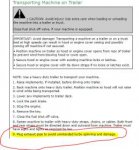Man...my head is spinning like a turbo...

I'll just follow the directions and guidance that's printed in my owners manual thanks...
Transporting Machine on Trailer
c CAUTION: Avoid injury! Use extra care when loading or unloading the machine into a trailer or truck.
Close fuel shut-off valve, if your machine is equipped.
IMPORTANT: Avoid damage! Transporting a machine on a trailer or on a truck bed at high speeds can result in hood or engine cover raising and possibly coming off machine if not secured.
***8226; Position machine on trailer so hood or engine cover opens from rear of trailer to prevent wind from blowing hood or cover open.
***8226; Secure hood or engine cover with existing machine locks or latches.
***8226; Secure hood or engine cover with tie down straps if no locks or latches exist.
NOTE: Use a heavy-duty trailer to transport your machine.
1. Raise implements, if installed, before driving onto trailer.
2. Back machine onto heavy duty trailer. Position machine so hood will not raise in wind while being transported.
3. Lower any implements to trailer deck.
4. Lock the park brake.
5. Stop the engine.
6. Remove the key.
7. Close the fuel shut-off valve.
8. Fasten machine to trailer with heavy-duty straps, chains, or cables. Both front and rear straps must be directed down and outward from machine. Trailer must have signs and lights as required by law.
9. Plug exhaust pipe to avoid unintended turbo spinning and damage.


